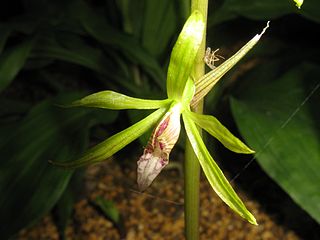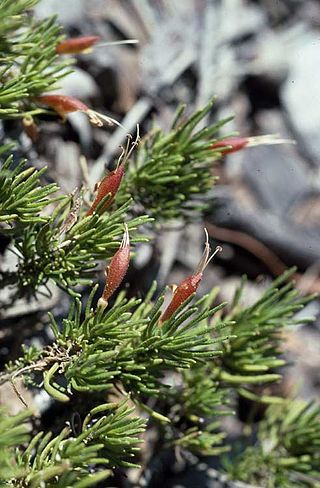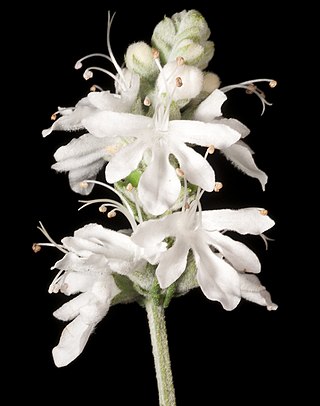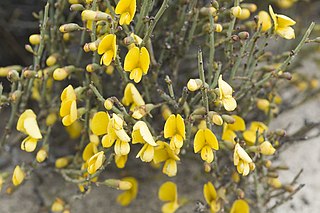
Banksia purdieana is a species of bushy shrub that is endemic to Western Australia. It has broadly linear, pinnatipartite leaves with sharply-pointed lobes on the sides, yellow flowers in heads of about eighty and egg-shaped follicles.

Aerangis biloba is a species of epiphytic orchid. It is native to tropical West Africa.

Nervilia concolor, commonly known as tall shield orchid, and to as Nervilia aragoana in Australia, is a small terrestrial orchid found in South Asia and Southeast Asia and in the northern regions of Australia. It has pale green, short-lived flowers with a cream-colored or yellowish labellum and a more or less circular leaf that emerges at the base of the flowering stem after flowering.

Cymboglossum, synonym Ascidieria, is a genus of flowering plants from the orchid family, Orchidaceae. It is native to Borneo, the Philippines, Sulawesi and Sumatra.

Calyptrochilum is a genus of flowering plants from the orchid family Orchidaceae native to tropical Africa, with one species extending into Brazil.
Gonatostylis is a genus of flowering plants from the orchid family, Orchidaceae. It contains only two species, both endemic to New Caledonia.
Lemurorchis is a genus of flowering plants from the orchid family, Orchidaceae. It contains only one known species, Lemurorchis madagascariensis, an epiphyte endemic to Madagascar.

Melaleuca depressa is a plant in the myrtle family, Myrtaceae and is endemic to the south-west of Western Australia. It is a small, bushy shrub with clusters of yellow or cream flowers on the ends of its branches in spring.

Eremophila calorhabdos, commonly known as red rod or spiked eremophila, is a flowering plant in the figwort family, Scrophulariaceae and is endemic to the south-west of Western Australia. It is a distinctive shrub with erect, rod-like branches up to 2.5 m (8 ft) high, leaves with small teeth along the edges, and flowers that change from orange to lipstick pink as they open.

Eremophila chamaephila, commonly known as earth-loving poverty bush, is a flowering plant in the figwort family, Scrophulariaceae, and is endemic to the south-west of Western Australia. It is a low, dense, spreading shrub with small, fleshy leaves and mauve to purple flowers.

Allocasuarina grevilleoides is a species of flowering plant in the family Casuarinaceae and is endemic to the south-west of Western Australia. It is a small, spreading, dioecious shrub that forms a lignotuber, and has more or less erect, sharply-pointed branchlets, the leaves reduced to scales in whorls of four, the mature fruiting cones 9–14 mm (0.35–0.55 in) long containing winged seeds (samaras) 5.5–7.0 mm (0.22–0.28 in) long.
Pterostylis bureaviana is a plant in the orchid family Orchidaceae and is endemic to New Caledonia. It was first formally described in 1906 by Rudolf Schlechter from a specimen collected on mountains near Païta and the description was published in the journal Botanische Jahrbücher für Systematik, Pflanzengeschichte und Pflanzengeographie. This greenhood orchid is found between Yaté and the Massif de Tchingou, growing in rainforest and dense humid forest, often in Nothofagus leaf litter.

Leucopogon tamminensis is a species of flowering plant in the heath family Ericaceae and is endemic to the southwest of Western Australia. It is a slender shrub with many branches, overlapping triangular to egg-shaped leaves and white, tube-shaped flower arranged singly in upper leaf axils.
Goodenia eremophila is a species of flowering plant in the family Goodeniaceae and is endemic to inland areas of Western Australia. It is an ascending herb with linear to elliptic leaves and thyrses of blue flowers.

Teucrium eremaeum is a species of flowering plant in the family Lamiaceae and is endemic to the south-west of Western Australia. It is a perennial herb or shrub with small, linear to lance-shaped leaves and white or cream-coloured flowers.
Teucrium myriocladum is a species of flowering plant in the family Lamiaceae and is endemic to the south-west of Western Australia. It is a shrub with small, hairy leaves and creamy-green flowers.
Goodenia nuda is a species of flowering plant in the family Goodeniaceae and is endemic to the Pilbara region of Western Australia. It is an erect to ascending herb with elliptic to lance-shaped leaves at the base of the plant, and racemes of yellow flowers.

Bossiaea leptacantha is a species of flowering plant in the family Fabaceae and is endemic to southern Western Australia. It is a low, compact, spreading, many-branched shrub, the branches ending in cladodes, the leaves reduced to small scales, and with deep yellow, red and greenish yellow flowers.
Pimelea gilgiana is a species of flowering plant in the family Thymelaeaceae and is endemic to near-coastal areas of north-western Western Australia. It is a shrub with narrowly egg-shaped leaves and head-like clusters of white or pinkish, dioecious flowers.
Thomasia dielsii is a species of flowering plant in the family Malvaceae and is endemic to the south-west of Western Australia. It is a low, erect to spreading shrub with egg-shaped leaves with wavy edges, and purple, violet and blue flowers.













